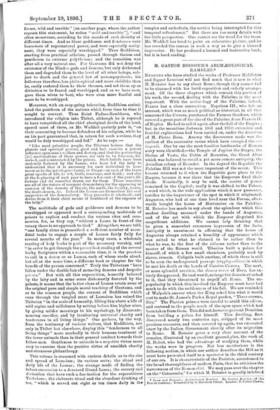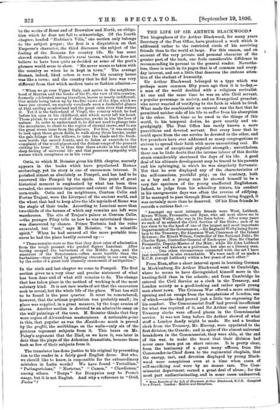M. GASTON BOISSIER'S ARCHAEOLOGICAL RAMBLES.*
READERS who have studied the works of Professor Middleton and Signor Lanciani will not find much that is new in what M. Boissier has to say about Rome, though they cannot fail to be charmed with his lucid exposition and orderly arrange- ment. Of the three chapters which contain this portion of his work, the second, dealing with the Palatine, is the most important. With the archaeology of the Palatine, indeed,. France has a close connection. Napoleon III., who felt an interest, which was as much political as historical, in all that concerned the Cmsars, purchased the Farnese Gardens, which covered a great part of the site of the Palatine, from Francis II. of Naples. He had to sell it again, after the fall of the Empire ; but in the meantime (between 1861 and 1870) extensive and fruitful explorations had been carried on, under the direction of M. Pietro Rosa. Among the discoveries made was the earliest of the successive towns which have occupied the e11; imperil. One by one the most familiar landmarks of Roman story were identified,—the Temple of Jupiter the Stayer, the Shrine of Vesta, the Cabin of Romulus, the Great Altar which was believed to recall a yet more remote antiquity, thee Arcadian colony of Evander. In the days of the Republic the Palatine Hill was not the most important of the seven. This honour returned to it when the Republic gave place to the Empire, because it was there that the Emperors fixed their abode. Nominally, it may be said, the centre of power remained in the Capitol; really it was shifted to the Palace, a word which, in the wide application which it now possesses,. testifies to the importance of the spot in which it originated. Augustus, who had at one time lived near the Forum, after- wards bought the house of Hortensius on the Palatine. M. Boissier has much to say about the splendour which this modest dwelling assumed under the hands of Augustus, and of the art with which the Emperor disguised his magnificent additions. We cannot help thinking that. he gives a somewhat erroneous impression of the facts.. Antiquity is unanimous in affirming that the house of Augustus always retained a humility of appearance which was suited to what he claimed to be rather than to what he was, to the first of the citizens rather than to the master of the Roman world. Tiberius built a palace for himself, of which a few small chambers, probably used by slaves, remain. Caligula built another, of which there is still to be seen the underground passage (cryptoporticus) in which• he met his death at the hands of Cassius Chrerea. The next, or more splendid erection, the domus attrca of Nero, has en- tirely disappeared. So vast was it, so large the domain attached to it, that they threatened to engulf all Rome. The un- popularity in which this involved the Emperor must have had much to do with the suddenness of his fall. We are reminded of Walpole's answer when the King asked him what it would cost to make St. James's Park a Royal garden, " Three crowns,. Sire." The Flavian princes were careful to avoid this odium, and restored to the people much of the open space which had been taken from them. This did not, however, prevent Dom itian from building a palace for himself. This dwelling, first discovered nearly two centuries ago, stripped of its most precious treasures, and then covered up again, was excavated anew by the Italian Government shortly after its migration to Rome. M. Boissier gives a very clear account of the remains, illustrated by an excellent ground-plan, the work of. M. Dalert, who had the advantage of studying them, while the works were in progress. Not less meritorious is the following section, in which our author describes the Hill as it must have presented itself to a spectator in the third century of our era. It is characteristic of the Parisian, accustomed to the broad thoroughfares of modern Paris, that he criticises the narrowness of the Roman c/ivi. We may pass over the chapters on the " Catacombs," for which M. Boissier is greatly indebted • Rome and Pompeii : Arehzological Enables. By Gaston Bnissier, of the Fretch Academy. Translated by D. Havelock Fisbor. London: T. Fisher trawl%
to the works of Rossi and of Brownlow and North, an obliga- tion which he does not fail to acknowledge. Of the fourth chapter, headed "Hadrian's Villa," one section only belongs to the subject proper; the first is a disquisition on that Emperor's character, the third discusses the subject of the feeling of the Romans for country life. He has some shrewd remarks on Horace's rural tastes, which he does not believe to have been quite as decided as some of the poet's
phrases would seem to show. " He never seems so taken with the country as when he is kept in town." The average Roman, indeed, liked urbem in rure, for his country house was like a town ; and the country that he did love was very different from that which modern taste or fashion admires:— "When we go over Upper Italy, and arrive in the neighbour- hood of Mantua and the banks of the Po, the view of this country, formerly celebrated among travellers, leaves us nearly indifferent. Our minds being taken up by the fine views of the Alps, which we have just crossed, we scarcely vouchsafe even a disdainful glance at that smiling meadowland and the great calm river that waters it. Yet it is the fatherland of Virgil, the country which he had before his eyes in his childhood, and which never left his heart. Those plains, to us so void of character, awoke in him the love of nature. In order to understand it, he did not need to plunge into the mountains, to climb to the region of eternal snows, and to see the great rivers issue from the glaciers. For him,' it was enough to look upon those green fields, to walk along these brooks, under the pale foliage of the willows, to take the shade and the fresh- ness beside the sacred founts, and to listen at eventide to the complaint of the wood-pigeon and the distant songs of the peasant cutting his trees.' It is thus that there awoke in his soul that -deep feeling of universal life and that generous sympathy with nature which enraptures us in his verse."
Ostia, to which M. Boissier gives his fifth chapter, scarcely
appears in the books which have popularised Roman archaeology, yet its story is one of uncommon interest. It perished almost as absolutely as Pompeii, and has had to be recovered like Pompeii by the spade. One point of great historical moment is emphasised by what has been thus revealed, the enormous importance and extent of the Roman corn-trade. Ostia and its neighbours, Centum Cellos and Portus Trajani, were the Liverpool of the ancient world, and the wheat that had to keep alive the idle myriads of Rome was the staple of their trade. According to Lanciani more than two-thirds of the houses of which any remains are left were warehouses. The site of Trajan's palace at Centum —the younger Pliny tells us how he was entertained there— was discovered by chance. Prince Torlonia had the ruins excavated, but "not," says M. Boissier, "in a scientific spirit." When he had secured all the more portable trea- sures he had the place hastily covered up :-
" These remains were so fine that they drew cries of admiration from the rough peasant who guided Signor Lanciani. After
h aving escaped the barbarians of the Middle Ages, and the amateurs of the Renaissance—often more terrible than the barbarians—they ended by perishing obscurely in our own days, by the order of a great lord clumsily enamoured of antiquities."
In the sixth and last chapter we come to Pompeii. The first section gives us a very clear and precise statement of what has been done and of what still remains to do. The change that has taken place in the method of working is of the most salutary kind. It is not rare works of art that the excavators seek to reveal, but the whole life of the place. What has still to be found is the poor quarter. It must be remembered, however, that the artisan population was probably small; its place was supplied, in a great measure, by the huge armies of slaves. Another section is devoted to an admirable essay on
the wall'paintings of the town. M. Boissier thinks that they were copies of Alexandrian masterpieces. A noticeable point is this, that popular as was the .2Eneid—so much is proved by the graffiti, the scribblings on the walls—only six of the
pictures represent subjects from it. This bears on Mr. Paley's argument that the Iliad, as we have it, was later in date than the plays of the Athenian dramatists, because these took so few of their subjects from it.
The translator has done justice to his original by presenting kim to the reader in a fairly good English dress. But who, we should like to know, is responsible for the extraordinary mistakes in Latin words? We have found " Turtullian," "Pathagoricians," " Nortetuo," " Cumea," " Claudienus," among others. "Denys" for Dionysius may be French Image, but it is not English. And why a reference to "Ovid, Fa:idea"?



































 Previous page
Previous page